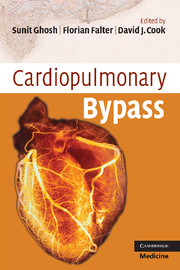Crossref Citations
This Book has been
cited by the following publications. This list is generated based on data provided by Crossref.
2012.
Core Topics in Cardiac Anesthesia.
p.
169.
Kelting, T
Searles, B
and
Darling, E
2012.
A survey on air bubble detector placement in the CPB circuit: a 2011 cross-sectional analysis of the practice of Certified Clinical Perfusionists.
Perfusion,
Vol. 27,
Issue. 4,
p.
345.
Parizkova, Barbora
and
Gray, Stephen J.
2012.
Core Topics in Cardiac Anesthesia.
p.
175.
Rigg, Laura
Searles, Bruce
and
Darling, Edward Morse
2014.
A 2013 Survey on Pressure Monitoring in Adult Cardiopulmonary Bypass Circuits: Modes and Applications.
The Journal of ExtraCorporeal Technology,
Vol. 46,
Issue. 4,
p.
287.
Tara, S. W.
Cheong, R. H. E.
and
Boonkiangwong, N.
2016.
Role of a perfusionist in patient blood management.
ISBT Science Series,
Vol. 11,
Issue. S2,
p.
86.
Ramadan, Mohamed Ehab
Buohliqah, Lamia
Crestanello, Juan
Ralston, James
Igoe, David
and
Awad, Hamdy
2016.
Iatrogenic aortic dissection after minimally invasive aortic valve replacement: a case report.
Journal of Cardiothoracic Surgery,
Vol. 11,
Issue. 1,
Faria, Mónica
and
De Pinho, Maria Norberta
2016.
Encyclopedia of Membranes.
p.
737.
Shlykov, Vladyslav
Kotovskyi, Vitalii
Višniakov, Nikolaj
Šešok, Andžela
and
Griškevičius., Julius
2018.
The IR-thermal imaging method for evaluation of the status of myocardial coronary vessels under the condition of artificial blood circulation.
Technology and Health Care,
Vol. 26,
Issue. ,
p.
571.
Hendrix, Rik H. J.
Ganushchak, Yuri M.
and
Weerwind, Patrick W.
2018.
Contemporary Oxygenator Design: Shear Stress‐Related Oxygen and Carbon Dioxide Transfer.
Artificial Organs,
Vol. 42,
Issue. 6,
p.
611.
Shlykov, Vladyslav
2018.
THE PROPAGATION OF THE TEMPERATURE WAVE IN MYOCARDIUM.
EUREKA: Physics and Engineering,
Vol. 2,
Issue. ,
p.
52.
Steel, Rona
and
Bui, Tri
2020.
Contemporary Australian priming constituents for adult perfusion centres: a survey.
Perfusion,
Vol. 35,
Issue. 8,
p.
778.
Fukaya, Aoi
Shiraishi, Yasuyuki
Inoue, Yusuke
Yamada, Akihiko
Sahara, Genta
Kudo, Takemi
Aizawa, Yasuhiro
and
Yambe, Tomoyuki
2021.
Development and accuracy evaluation of a degree of occlusion visualization system for roller pumps used in cardiopulmonary bypass.
Journal of Artificial Organs,
Vol. 24,
Issue. 1,
p.
27.
Zamzami, Bandar
and
Alghamdi, Abdullah Ali
2024.
Manual of Pediatric Cardiac Care.
p.
33.
Libertino, John A.
Ahmed, Malik
Piemonte, Thomas
and
Gee, Jason
2025.
Endovascular Downstaging: A New Method for Managing Renal Cell Carcinoma Tumor Thrombus Invading the Inferior Vena Cava Above the Hepatic Veins (Level III) or into the Heart (Level IV).
Cancers,
Vol. 17,
Issue. 2,
p.
264.



